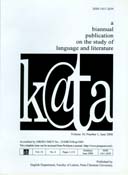In search of self: Navigating subjectivity amidst conflicts in Rainbow Rowell’s Eleanor & Park (2012)
Abstract
Entrance into adulthood has often been seen as a phase marked by self-exploration, instability, and struggles to overcome tensions and conflicts. Eleanor & Park (2012) is a novel that explores issues of growing up and tells the story of how the two main characters go through the struggles of their adolescent lives. This study analyzes how Eleanor and Park construct and navigate their subjectivities amidst the various conflicts they face. It does so by, first, identifying and classifying the conflicts the characters encounter and then locating their provisional subject positions that draw on how they react to and deal with the conflicts. While the study confirms the dynamic nature of subject positions, both Eleanor and Park tend to bring to the fore their active subject position in dealing with the conflicts. Moreover, their subject positions further indicate that Eleanor and Park are empowered agents who are capable of deliberating thoughts and actions consciously. In navigating their subjectivities, both characters, in the end, are able to achieve personal growth and empowerment.
Downloads
References
Bahri, S., & Dewi, N. (2015). The conflicts in Shakespeare’s drama Hamlet. Medan: Universitas Negeri Medan.
Barker, C. (2000). Cultural Studies: Theory and Practice. London: SAGE.
Baumeister, R. (1997). Identity, self-concept, and self-esteem: The self-lost and found. In R. Hogan, J. A. Johnson, & S. R. Brigss (Eds.), Handbook of personality psychology (pp. 681-710). San Diego, CA, US: Academic Press.
Bean, T., & Moni, K. B. (2003). Developing students’ critical literacy: Exploring identity construction in young adult fiction. Journal of Adolescent and Adult Literacy, 46(8), 638- 648. doi: 10.2307/40017169
Burger, A. (2016). Coming of age stories. In Teaching Stephen King (pp. 103- 117). New York: Palgrave Macmillan. doi: 10.1057/978113748391 1_8
Campbell, P. (2010). Reflections on young adult literature. Lanham: Scarecrow Press, Inc.
Garcia, A. (2013). Critical foundations in young adult literature. Rotterdam: Sense Publishers.
Javaheri, Z. (2018). Subjectivity in young adult literature (Philip Pullman’s His Dark Materials, Marjane Satrapi’s Persepolis [Master’s thesis, The University of Western Ontario]. Western Libraries.
Koss, M. D., & Teale, W. H. (2009). What’s happening in YA literature? Trends in books for adolescents. Journal of Adolescent & Adult Literacy 52(7), 563572. doi:10.1598/JAAL.52.7. 2
Lamb, N. (2008). The art and craft of storytelling: A comprehensive guide to classic writing techniques. Ohio: Writer’s Digest Books.
Littletan, S., & Caldwell, C. (2011). Literature study guide and student workbook. BMI Educational Services.
McCallum, R. (1999). Ideologies of identity in adolescent fiction: The dialogic construction of subjectivity. New York: Routledge.
Millet, A. M. (2015). Only a body “who nobody owns:” Adolescent identity in Neil Gaiman’s The Graveyard Book [Master’s thesis, Eastern Michigan University]. Eastern Michigan University Library.
Nafisah, N. (2020). Gaining harmony: Glocal subjectivity in two Indonesian films for children. International Research in Children’s Literature 13(1), 31-44. DOI: 10.3366/ircl.2020.0326
Nikolajeva, M. (2014). Memory of the present: Empathy and identity in young adult fiction. Narrative Works: Issues, Investigations, & Interventions, 4(2), 86- 107.
Nilsen, A. P., & Donelson, K. L. (2008). Literature for today’s young adults. United States of America: Pearson Education.
Paulsen, D., Platt, M., Huettel, S., & Brannon, E. (2011). Decision-making under risk in children, adolescents, and young adults. Frontiers in Psychology, 2(72). doi: 10.3389/fpsyg.2011.000 72.
Rahma, F. R. (2015). The construction of happiness through female subjectivity in Pensri Kiengsiri’s Arrival of Dawn. Repository Indonesia University of Education. Retrieved from: http://repository.upi.edu /17368/
Rauer, A. J., Pettit, G. S., Lansford, J. E., Bates, J. E., & Dodge, K. A. (2013). Romantic relationship patterns in young adulthood and their developmental antecedents. Developmental Psychology, 49(11), 2159–2171. doi: 10.1037/a0031845.
Sheikh, F. A. (2017). Subjectivity, desire and theory: Reading Lacan. Cogent Arts and Humanities, 4(1). doi:10.1080/23311983.2 017.1299565
Tiainen, A. (2013). Becoming Jane: Identity, dependency and autonomy in Charlotte Bronte’s Jane Eyre [Master’s thesis, University of Tampere]. Semantic Scholar.
Trupe, A. (2006). Thematic guide to young adult literature. Westport: Greenwood Press.
Wijayanti, R., & Rusdiarti, S. (2018). Subjectivity of women in the work of Seno Gumira Adjidarma Drupadi. Advances in Social Science, Education and Humanities Research, 257, 19-23. doi: 10.2991/icollite 18.2019.4

This work is licensed under a Creative Commons Attribution 4.0 International License.
This work is licensed under a Creative Commons Attribution License


















